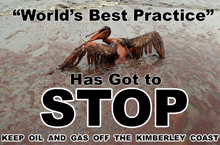 OIL SPILLS: Cable Beach. The Timor Sea. The Gulf of Mexico. As we digest the daily updates on BP’s oil disaster in the Gulf of Mexico, those of us considering the impacts of the potential industrial development on the Kimberley coastline see more and more reason for great caution.
Even the President of the United States is now heralding a new era equal to the impact of September 11 in which the environment is not put at such risk because the world will no longer tolerate it.
This would seem to spell significant delays if not abandonment of the Woodside proposal to bring gas onshore in the Kimberley because it conflicts with basic good sense in the light of these recent events.
Why? Well, the last twelve months saw the WA and Federal government pushing so hard for greenfield industrial development on the Kimberley coastline that indigenous permissions, critical to its go-ahead, were plagued by their indecent haste.
Now, it appears there was never any valid agreement from Aborigines to sign off on the deal.
And the Federal Court is hearing an action against the KLC that Premier Barnett has said will prevent an ILUA being signed (for use of the land) by his previously confident June 30, 2010 deadline.
Throughout, Woodside and the WA government has appeared to stubbornly resist consideration of viable alternatives.
Then came disturbing hints that all is not safe and sound in the world of offshore mining.
In the same 12 months, oil spills have affected the Kimberley, the Great Barrier Reef and now the world’s greatest economy, with the worst-ever oil spill offshore southern USA.
These accidents have caused concern due to an apparent lack of accountability and the absence of fix-it-up engineering to battle what industry previously boasted about as state of the art technology — their wizardry now gone horribly wrong.
Woodside has constantly trumpeted “latest technology” for its Kimberley projects. But what good is cutting edge technology to enable such exploration and exploitation of the world’s resources if an error results in a devastating disaster of international proportions?
As President Obama has said overnight, the World will now change and demand more from our governments and resource giants in terms of environmental safety.
Those in political and economic power in this country would be wise to note some of Obama’s stern words to American oil companies: “For a decade or more, the cozy relationship between the oil companies and the federal agency was allowed to go unchecked,” President Obama said in a statement released late Tuesday afternoon. “That allowed drilling permits to be issued in exchange not for safety plans, but assurances of safety from oil companies. That cannot and will not happen anymore.”
We have reached a moment in history when there will be more confident arguments against the proliferation of industrial development in the invaluable and pristine Kimberley region.
Greater scrutiny will precede projects before irreparable damage can be done.
Let’s hope this will stop the incessant reporting of yet more environmental devastation here and around the world as the Kimberley’s future gets decided by those who have clearly underrated the risks.
And, we must keep reminding them of this past 12 months —
Cable Beach. It has been almost a year since locals got a taste of what industrial spillage is like: 40 kilometres of local beaches from Coconut Well to Cable Beach and all the way to RAMSAR listed Roebuck Bay were covered in oil globules. The Port Authority cleaned up the mess and apparently did tests to determine who the culprit or culprits were, but locals still remain mystified at how the mess arrived to their shores and who was responsible.
Montara. From August 2009, a blow-out on PTTEP’s Montara oil field well head platform leaked oil into the Timor Sea for ten weeks, in a spill that’s rated as Australia’s third largest ever. An inquiry into the disaster heard that the well’s cementing was significantly weaker than it should have been and that that was one of the underlying causes of the blowout. PTTEP’s Chief Operating Officer Andy Jacob told the inquiry that the company’s two senior Perth-based managers had all the information they needed to know there was a problem with the cementing of the well. He also told the inquiry that not one of the five wells PTTEP own had been suspended (as of the April inquiry) the way it should be, according to the company’s own safety guidelines, given the 2009 accident.
Testing of a sample from the well confirms that during the 10 weeks that it flowed, crude oil did spread beyond Australian waters. Indonesian villagers claimed last year that oil from the Montara Well Head affected their health and killed their fish. Analysis by Leeder Consulting shows a sample collected off West Timor is similar to Montara crude.
Gulf of Mexico. An explosion on April 20 aboard BP’s Deepwater Horizon drilling rig working on a well for the oil company BP of the Gulf of Mexico, has led to the largest oil spill in the history of the United States. Both government and company officials say oil will likely continue flowing until a relief well cuts off the gusher, which is not predicted to occur until August.
By mid-June, the amount of oil spilled had already reached four times the amount that flowed from the wreck of the Exxon Valdez, which spilled about 250,000 barrels of oil into Prince Williams Bay in Alaska in 1989. The size of the leak was at first estimated at about 1,000 barrels of oil a day, but five weeks later government scientists presented a new range of estimates, in the range of a whopping 12,000 to 25,000 barrels a day.
The U.S. Justice Department announced a criminal inquiry into the disaster on the 1st of June to determine if any of the parties involved had violated environmental laws. . All three companies – BP, which was leasing the rig; Transocean, which owned the rig; and Halliburton, which was involved in the effort to seal the well that preceded the blast -have sought to deflect blame onto the others. This much is known at the moment: An internal memo showed that BP had chosen the cheaper of two methods of capping, despite worries about the risks involved.
The Deepwater Horizon was described before the accident as one of the most technologically advanced drilling platforms in the world. Experts in the field regularly tell civilians that industrial accidents in the oil and gas industry are incredibly rare. In defense of the proposed gas processing plant in the Kimberley, Barnett has trumpeted these same mantras. Concerned citizens are wise to doubt these words.
For more information and more resources, please have a look at the following blogspots:
Hands off Country — http://handsoffcountry.blogspot.com
Friends of Price’s Point — http://bk-bkpricespoint.blogspot.com
OIL SPILLS: Cable Beach. The Timor Sea. The Gulf of Mexico. As we digest the daily updates on BP’s oil disaster in the Gulf of Mexico, those of us considering the impacts of the potential industrial development on the Kimberley coastline see more and more reason for great caution.
Even the President of the United States is now heralding a new era equal to the impact of September 11 in which the environment is not put at such risk because the world will no longer tolerate it.
This would seem to spell significant delays if not abandonment of the Woodside proposal to bring gas onshore in the Kimberley because it conflicts with basic good sense in the light of these recent events.
Why? Well, the last twelve months saw the WA and Federal government pushing so hard for greenfield industrial development on the Kimberley coastline that indigenous permissions, critical to its go-ahead, were plagued by their indecent haste.
Now, it appears there was never any valid agreement from Aborigines to sign off on the deal.
And the Federal Court is hearing an action against the KLC that Premier Barnett has said will prevent an ILUA being signed (for use of the land) by his previously confident June 30, 2010 deadline.
Throughout, Woodside and the WA government has appeared to stubbornly resist consideration of viable alternatives.
Then came disturbing hints that all is not safe and sound in the world of offshore mining.
In the same 12 months, oil spills have affected the Kimberley, the Great Barrier Reef and now the world’s greatest economy, with the worst-ever oil spill offshore southern USA.
These accidents have caused concern due to an apparent lack of accountability and the absence of fix-it-up engineering to battle what industry previously boasted about as state of the art technology — their wizardry now gone horribly wrong.
Woodside has constantly trumpeted “latest technology” for its Kimberley projects. But what good is cutting edge technology to enable such exploration and exploitation of the world’s resources if an error results in a devastating disaster of international proportions?
As President Obama has said overnight, the World will now change and demand more from our governments and resource giants in terms of environmental safety.
Those in political and economic power in this country would be wise to note some of Obama’s stern words to American oil companies: “For a decade or more, the cozy relationship between the oil companies and the federal agency was allowed to go unchecked,” President Obama said in a statement released late Tuesday afternoon. “That allowed drilling permits to be issued in exchange not for safety plans, but assurances of safety from oil companies. That cannot and will not happen anymore.”
We have reached a moment in history when there will be more confident arguments against the proliferation of industrial development in the invaluable and pristine Kimberley region.
Greater scrutiny will precede projects before irreparable damage can be done.
Let’s hope this will stop the incessant reporting of yet more environmental devastation here and around the world as the Kimberley’s future gets decided by those who have clearly underrated the risks.
And, we must keep reminding them of this past 12 months —
Cable Beach. It has been almost a year since locals got a taste of what industrial spillage is like: 40 kilometres of local beaches from Coconut Well to Cable Beach and all the way to RAMSAR listed Roebuck Bay were covered in oil globules. The Port Authority cleaned up the mess and apparently did tests to determine who the culprit or culprits were, but locals still remain mystified at how the mess arrived to their shores and who was responsible.
Montara. From August 2009, a blow-out on PTTEP’s Montara oil field well head platform leaked oil into the Timor Sea for ten weeks, in a spill that’s rated as Australia’s third largest ever. An inquiry into the disaster heard that the well’s cementing was significantly weaker than it should have been and that that was one of the underlying causes of the blowout. PTTEP’s Chief Operating Officer Andy Jacob told the inquiry that the company’s two senior Perth-based managers had all the information they needed to know there was a problem with the cementing of the well. He also told the inquiry that not one of the five wells PTTEP own had been suspended (as of the April inquiry) the way it should be, according to the company’s own safety guidelines, given the 2009 accident.
Testing of a sample from the well confirms that during the 10 weeks that it flowed, crude oil did spread beyond Australian waters. Indonesian villagers claimed last year that oil from the Montara Well Head affected their health and killed their fish. Analysis by Leeder Consulting shows a sample collected off West Timor is similar to Montara crude.
Gulf of Mexico. An explosion on April 20 aboard BP’s Deepwater Horizon drilling rig working on a well for the oil company BP of the Gulf of Mexico, has led to the largest oil spill in the history of the United States. Both government and company officials say oil will likely continue flowing until a relief well cuts off the gusher, which is not predicted to occur until August.
By mid-June, the amount of oil spilled had already reached four times the amount that flowed from the wreck of the Exxon Valdez, which spilled about 250,000 barrels of oil into Prince Williams Bay in Alaska in 1989. The size of the leak was at first estimated at about 1,000 barrels of oil a day, but five weeks later government scientists presented a new range of estimates, in the range of a whopping 12,000 to 25,000 barrels a day.
The U.S. Justice Department announced a criminal inquiry into the disaster on the 1st of June to determine if any of the parties involved had violated environmental laws. . All three companies – BP, which was leasing the rig; Transocean, which owned the rig; and Halliburton, which was involved in the effort to seal the well that preceded the blast -have sought to deflect blame onto the others. This much is known at the moment: An internal memo showed that BP had chosen the cheaper of two methods of capping, despite worries about the risks involved.
The Deepwater Horizon was described before the accident as one of the most technologically advanced drilling platforms in the world. Experts in the field regularly tell civilians that industrial accidents in the oil and gas industry are incredibly rare. In defense of the proposed gas processing plant in the Kimberley, Barnett has trumpeted these same mantras. Concerned citizens are wise to doubt these words.
For more information and more resources, please have a look at the following blogspots:
Hands off Country — http://handsoffcountry.blogspot.com
Friends of Price’s Point — http://bk-bkpricespoint.blogspot.com
MULTIPLE ACCIDENTS ARE A GRAVE WARNING
 OIL SPILLS: Cable Beach. The Timor Sea. The Gulf of Mexico. As we digest the daily updates on BP’s oil disaster in the Gulf of Mexico, those of us considering the impacts of the potential industrial development on the Kimberley coastline see more and more reason for great caution.
Even the President of the United States is now heralding a new era equal to the impact of September 11 in which the environment is not put at such risk because the world will no longer tolerate it.
This would seem to spell significant delays if not abandonment of the Woodside proposal to bring gas onshore in the Kimberley because it conflicts with basic good sense in the light of these recent events.
Why? Well, the last twelve months saw the WA and Federal government pushing so hard for greenfield industrial development on the Kimberley coastline that indigenous permissions, critical to its go-ahead, were plagued by their indecent haste.
Now, it appears there was never any valid agreement from Aborigines to sign off on the deal.
And the Federal Court is hearing an action against the KLC that Premier Barnett has said will prevent an ILUA being signed (for use of the land) by his previously confident June 30, 2010 deadline.
Throughout, Woodside and the WA government has appeared to stubbornly resist consideration of viable alternatives.
Then came disturbing hints that all is not safe and sound in the world of offshore mining.
In the same 12 months, oil spills have affected the Kimberley, the Great Barrier Reef and now the world’s greatest economy, with the worst-ever oil spill offshore southern USA.
These accidents have caused concern due to an apparent lack of accountability and the absence of fix-it-up engineering to battle what industry previously boasted about as state of the art technology — their wizardry now gone horribly wrong.
Woodside has constantly trumpeted “latest technology” for its Kimberley projects. But what good is cutting edge technology to enable such exploration and exploitation of the world’s resources if an error results in a devastating disaster of international proportions?
As President Obama has said overnight, the World will now change and demand more from our governments and resource giants in terms of environmental safety.
Those in political and economic power in this country would be wise to note some of Obama’s stern words to American oil companies: “For a decade or more, the cozy relationship between the oil companies and the federal agency was allowed to go unchecked,” President Obama said in a statement released late Tuesday afternoon. “That allowed drilling permits to be issued in exchange not for safety plans, but assurances of safety from oil companies. That cannot and will not happen anymore.”
We have reached a moment in history when there will be more confident arguments against the proliferation of industrial development in the invaluable and pristine Kimberley region.
Greater scrutiny will precede projects before irreparable damage can be done.
Let’s hope this will stop the incessant reporting of yet more environmental devastation here and around the world as the Kimberley’s future gets decided by those who have clearly underrated the risks.
And, we must keep reminding them of this past 12 months —
Cable Beach. It has been almost a year since locals got a taste of what industrial spillage is like: 40 kilometres of local beaches from Coconut Well to Cable Beach and all the way to RAMSAR listed Roebuck Bay were covered in oil globules. The Port Authority cleaned up the mess and apparently did tests to determine who the culprit or culprits were, but locals still remain mystified at how the mess arrived to their shores and who was responsible.
Montara. From August 2009, a blow-out on PTTEP’s Montara oil field well head platform leaked oil into the Timor Sea for ten weeks, in a spill that’s rated as Australia’s third largest ever. An inquiry into the disaster heard that the well’s cementing was significantly weaker than it should have been and that that was one of the underlying causes of the blowout. PTTEP’s Chief Operating Officer Andy Jacob told the inquiry that the company’s two senior Perth-based managers had all the information they needed to know there was a problem with the cementing of the well. He also told the inquiry that not one of the five wells PTTEP own had been suspended (as of the April inquiry) the way it should be, according to the company’s own safety guidelines, given the 2009 accident.
Testing of a sample from the well confirms that during the 10 weeks that it flowed, crude oil did spread beyond Australian waters. Indonesian villagers claimed last year that oil from the Montara Well Head affected their health and killed their fish. Analysis by Leeder Consulting shows a sample collected off West Timor is similar to Montara crude.
Gulf of Mexico. An explosion on April 20 aboard BP’s Deepwater Horizon drilling rig working on a well for the oil company BP of the Gulf of Mexico, has led to the largest oil spill in the history of the United States. Both government and company officials say oil will likely continue flowing until a relief well cuts off the gusher, which is not predicted to occur until August.
By mid-June, the amount of oil spilled had already reached four times the amount that flowed from the wreck of the Exxon Valdez, which spilled about 250,000 barrels of oil into Prince Williams Bay in Alaska in 1989. The size of the leak was at first estimated at about 1,000 barrels of oil a day, but five weeks later government scientists presented a new range of estimates, in the range of a whopping 12,000 to 25,000 barrels a day.
The U.S. Justice Department announced a criminal inquiry into the disaster on the 1st of June to determine if any of the parties involved had violated environmental laws. . All three companies – BP, which was leasing the rig; Transocean, which owned the rig; and Halliburton, which was involved in the effort to seal the well that preceded the blast -have sought to deflect blame onto the others. This much is known at the moment: An internal memo showed that BP had chosen the cheaper of two methods of capping, despite worries about the risks involved.
The Deepwater Horizon was described before the accident as one of the most technologically advanced drilling platforms in the world. Experts in the field regularly tell civilians that industrial accidents in the oil and gas industry are incredibly rare. In defense of the proposed gas processing plant in the Kimberley, Barnett has trumpeted these same mantras. Concerned citizens are wise to doubt these words.
For more information and more resources, please have a look at the following blogspots:
Hands off Country — http://handsoffcountry.blogspot.com
Friends of Price’s Point — http://bk-bkpricespoint.blogspot.com
OIL SPILLS: Cable Beach. The Timor Sea. The Gulf of Mexico. As we digest the daily updates on BP’s oil disaster in the Gulf of Mexico, those of us considering the impacts of the potential industrial development on the Kimberley coastline see more and more reason for great caution.
Even the President of the United States is now heralding a new era equal to the impact of September 11 in which the environment is not put at such risk because the world will no longer tolerate it.
This would seem to spell significant delays if not abandonment of the Woodside proposal to bring gas onshore in the Kimberley because it conflicts with basic good sense in the light of these recent events.
Why? Well, the last twelve months saw the WA and Federal government pushing so hard for greenfield industrial development on the Kimberley coastline that indigenous permissions, critical to its go-ahead, were plagued by their indecent haste.
Now, it appears there was never any valid agreement from Aborigines to sign off on the deal.
And the Federal Court is hearing an action against the KLC that Premier Barnett has said will prevent an ILUA being signed (for use of the land) by his previously confident June 30, 2010 deadline.
Throughout, Woodside and the WA government has appeared to stubbornly resist consideration of viable alternatives.
Then came disturbing hints that all is not safe and sound in the world of offshore mining.
In the same 12 months, oil spills have affected the Kimberley, the Great Barrier Reef and now the world’s greatest economy, with the worst-ever oil spill offshore southern USA.
These accidents have caused concern due to an apparent lack of accountability and the absence of fix-it-up engineering to battle what industry previously boasted about as state of the art technology — their wizardry now gone horribly wrong.
Woodside has constantly trumpeted “latest technology” for its Kimberley projects. But what good is cutting edge technology to enable such exploration and exploitation of the world’s resources if an error results in a devastating disaster of international proportions?
As President Obama has said overnight, the World will now change and demand more from our governments and resource giants in terms of environmental safety.
Those in political and economic power in this country would be wise to note some of Obama’s stern words to American oil companies: “For a decade or more, the cozy relationship between the oil companies and the federal agency was allowed to go unchecked,” President Obama said in a statement released late Tuesday afternoon. “That allowed drilling permits to be issued in exchange not for safety plans, but assurances of safety from oil companies. That cannot and will not happen anymore.”
We have reached a moment in history when there will be more confident arguments against the proliferation of industrial development in the invaluable and pristine Kimberley region.
Greater scrutiny will precede projects before irreparable damage can be done.
Let’s hope this will stop the incessant reporting of yet more environmental devastation here and around the world as the Kimberley’s future gets decided by those who have clearly underrated the risks.
And, we must keep reminding them of this past 12 months —
Cable Beach. It has been almost a year since locals got a taste of what industrial spillage is like: 40 kilometres of local beaches from Coconut Well to Cable Beach and all the way to RAMSAR listed Roebuck Bay were covered in oil globules. The Port Authority cleaned up the mess and apparently did tests to determine who the culprit or culprits were, but locals still remain mystified at how the mess arrived to their shores and who was responsible.
Montara. From August 2009, a blow-out on PTTEP’s Montara oil field well head platform leaked oil into the Timor Sea for ten weeks, in a spill that’s rated as Australia’s third largest ever. An inquiry into the disaster heard that the well’s cementing was significantly weaker than it should have been and that that was one of the underlying causes of the blowout. PTTEP’s Chief Operating Officer Andy Jacob told the inquiry that the company’s two senior Perth-based managers had all the information they needed to know there was a problem with the cementing of the well. He also told the inquiry that not one of the five wells PTTEP own had been suspended (as of the April inquiry) the way it should be, according to the company’s own safety guidelines, given the 2009 accident.
Testing of a sample from the well confirms that during the 10 weeks that it flowed, crude oil did spread beyond Australian waters. Indonesian villagers claimed last year that oil from the Montara Well Head affected their health and killed their fish. Analysis by Leeder Consulting shows a sample collected off West Timor is similar to Montara crude.
Gulf of Mexico. An explosion on April 20 aboard BP’s Deepwater Horizon drilling rig working on a well for the oil company BP of the Gulf of Mexico, has led to the largest oil spill in the history of the United States. Both government and company officials say oil will likely continue flowing until a relief well cuts off the gusher, which is not predicted to occur until August.
By mid-June, the amount of oil spilled had already reached four times the amount that flowed from the wreck of the Exxon Valdez, which spilled about 250,000 barrels of oil into Prince Williams Bay in Alaska in 1989. The size of the leak was at first estimated at about 1,000 barrels of oil a day, but five weeks later government scientists presented a new range of estimates, in the range of a whopping 12,000 to 25,000 barrels a day.
The U.S. Justice Department announced a criminal inquiry into the disaster on the 1st of June to determine if any of the parties involved had violated environmental laws. . All three companies – BP, which was leasing the rig; Transocean, which owned the rig; and Halliburton, which was involved in the effort to seal the well that preceded the blast -have sought to deflect blame onto the others. This much is known at the moment: An internal memo showed that BP had chosen the cheaper of two methods of capping, despite worries about the risks involved.
The Deepwater Horizon was described before the accident as one of the most technologically advanced drilling platforms in the world. Experts in the field regularly tell civilians that industrial accidents in the oil and gas industry are incredibly rare. In defense of the proposed gas processing plant in the Kimberley, Barnett has trumpeted these same mantras. Concerned citizens are wise to doubt these words.
For more information and more resources, please have a look at the following blogspots:
Hands off Country — http://handsoffcountry.blogspot.com
Friends of Price’s Point — http://bk-bkpricespoint.blogspot.com
No comments yet
The comments are closed.








